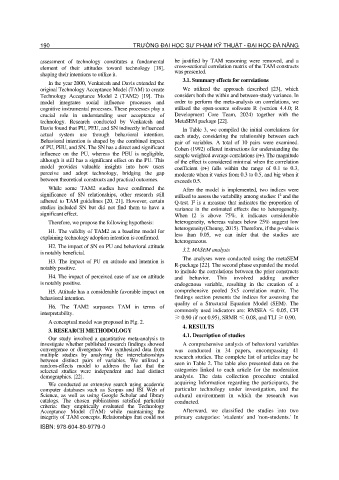Page 199 - Kỷ yếu hội thảo quốc tế: Ứng dụng công nghệ mới trong công trình xanh - lần thứ 9 (ATiGB 2024)
P. 199
190 TRƯỜNG ĐẠI HỌC SƯ PHẠM KỸ THUẬT - ĐẠI HỌC ĐÀ NẴNG
assessment of technology constitutes a fundamental be justified by TAM reasoning were removed, and a
element of their attitudes toward technology [18], cross-sectional correlation matrix of the TAM constructs
shaping their intentions to utilize it. was presented.
3.1. Summary effects for correlations
In the year 2000, Venkatesh and Davis extended the
original Technology Acceptance Model (TAM) to create We utilized the approach described [23], which
Technology Acceptance Model 2 (TAM2) [19]. This considers both the within and between-study variance. In
model integrates social influence processes and order to perform the meta-analysis on correlations, we
cognitive instrumental processes. These processes play a utilized the open-source software R (version 4.4.0; R
crucial role in understanding user acceptance of Development Core Team, 2024) together with the
technology. Research conducted by Venkatesh and MetaSEM package [22].
Davis found that PU, PEU, and SN indirectly influenced In Table 3, we compiled the initial correlations for
actual system use through behavioral intention. each study, considering the relationship between each
Behavioral intention is shaped by the combined impact pair of variables. A total of 10 pairs were examined.
of PU, PEU, and SN. The SN has a direct and significant Cohen (1992) offered instructions for understanding the
influence on the PU, whereas the PEU is negligible, sample weighted average correlations (r+). The magnitude
although it still has a significant effect on the PU. This of the effect is considered minimal when the correlation
model provides valuable insights into how users coefficient (r+) falls within the range of 0.1 to 0.3,
perceive and adopt technology, bridging the gap moderate when it varies from 0.3 to 0.5, and big when it
between theoretical constructs and practical outcomes. exceeds 0.5.
While some TAM2 studies have confirmed the After the model is implemented, two indices were
significance of SN relationships, other research still utilized to assess the variability among studies: I and the
2
adhered to TAM guidelines [20, 21]. However, certain Q-test. I is a measure that indicates the proportion of
2
studies included SN but did not find them to have a variance in the estimated effects due to heterogeneity.
significant effect. When I2 is above 75%, it indicates considerable
Therefore, we propose the following hypothesis: heterogeneity, whereas values below 25% suggest low
heterogeneity(Cheung, 2015). Therefore, if the p-value is
H1. The validity of TAM2 as a baseline model for
explaining technology adoption intention is confirmed. less than 0.05, we can infer that the studies are
heterogeneous.
H2. The impact of SN on PU and behavioral attitude
is notably beneficial. 3.2. MASEM analysis
The analyses were conducted using the metaSEM
H3. The impact of PU on attitude and intention is
notably positive. R-package [22]. The second phase expanded the model
to include the correlations between the prior constructs
H4. The impact of perceived ease of use on attitude and behavior. This involved adding another
is notably positive. endogenous variable, resulting in the creation of a
H5. Attitude has a considerable favorable impact on comprehensive pooled 5x5 correlation matrix. The
behavioral intention. findings section presents the indices for assessing the
quality of a Structural Equation Model (SEM). The
H6. The TAM2 surpasses TAM in terms of
interpretability. commonly used indicators are: RMSEA ≤ 0.05, CFI
≥ 0.90 (if not 0.95), SRMR ≤ 0.08, and TLI ≥ 0.90.
A conceptual model was proposed in Fig. 2.
4. RESULTS
3. RESEARCH METHODOLOGY
Our study involved a quantitative meta-analysis to 4.1. Description of studies
investigate whether published research findings showed A comprehensive analysis of behavioral variables
convergence or divergence. We synthesized data from was conducted in 34 papers, encompassing 41
multiple studies by analyzing the interrelationships research studies. The complete list of articles may be
between distinct pairs of variables. We utilized a
random-effects model to address the fact that the seen in Table 2. The table also presented data on the
selected studies were independent and had distinct categories linked to each article for the moderation
demographics. [22]. analysis. The data collection procedure entailed
We conducted an extensive search using academic acquiring Information regarding the participants, the
computer databases such as Scopus and ISI Web of particular technology under investigation, and the
Science, as well as using Google Scholar and library cultural environment in which the research was
catalogs. The chosen publications satisfied particular conducted.
criteria: they empirically evaluated the Technology
Acceptance Model (TAM) while maintaining the Afterward, we classified the studies into two
integrity of TAM concepts. Relationships that could not primary categories: 'students' and 'non-students.' In
ISBN: 978-604-80-9779-0

